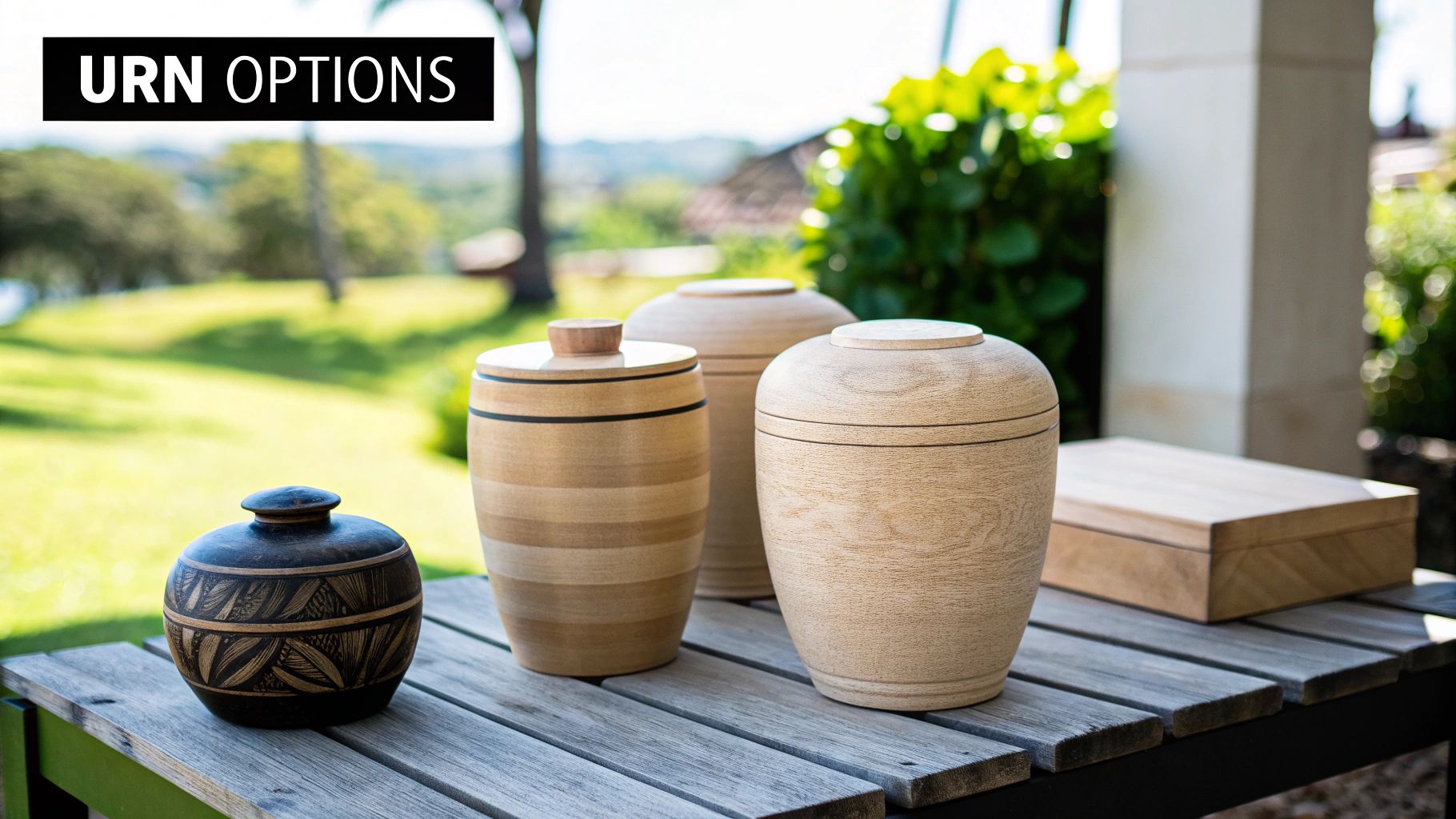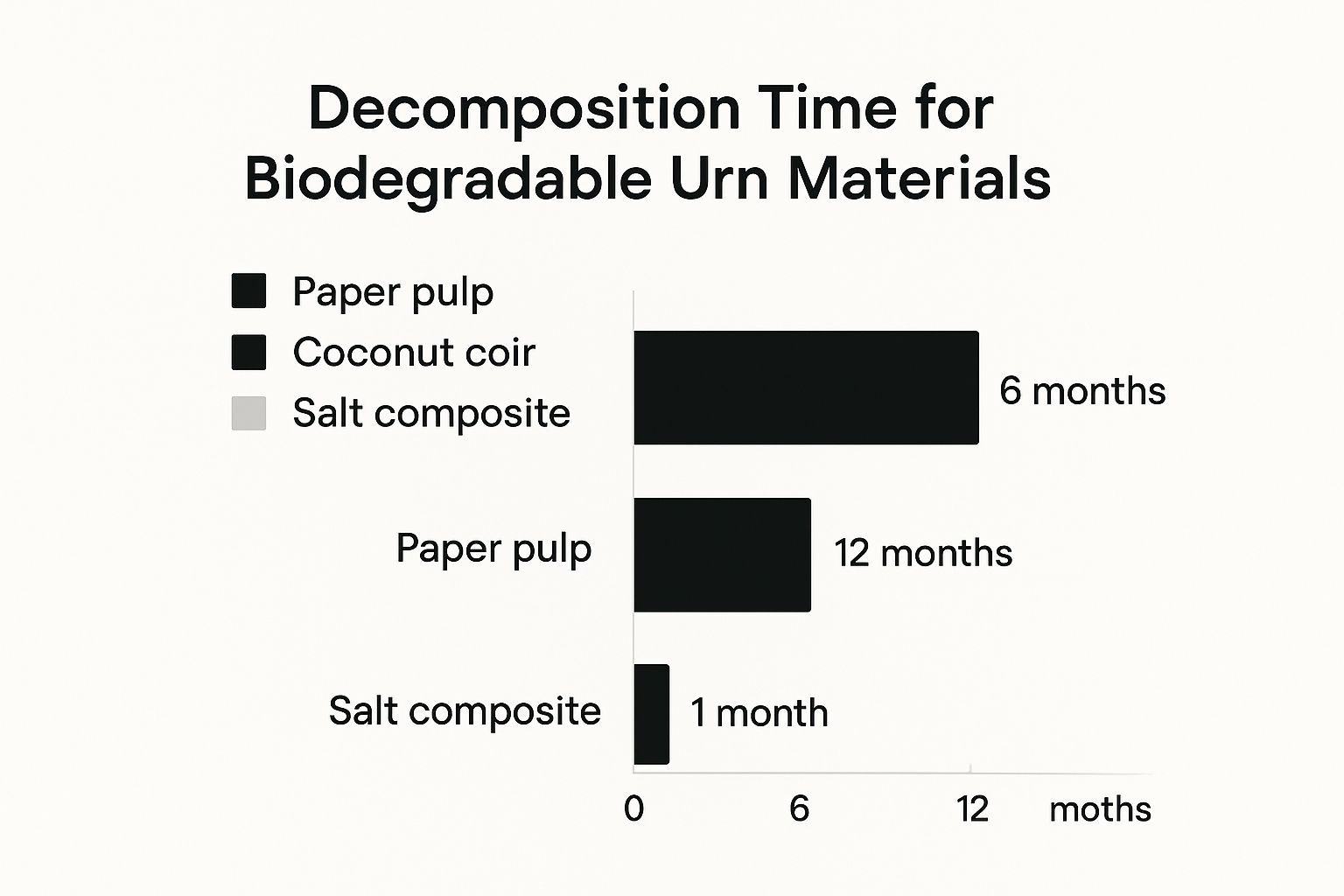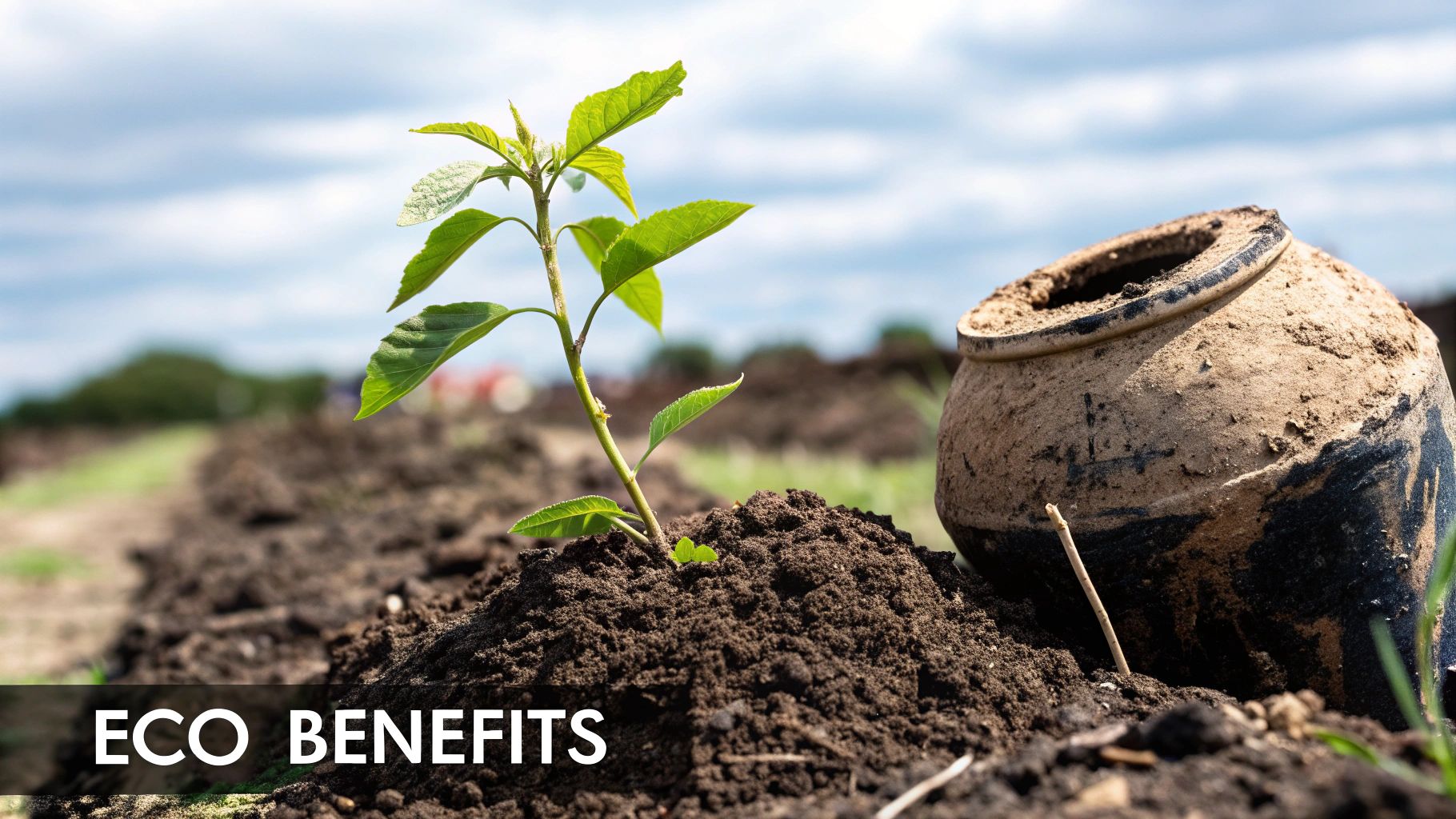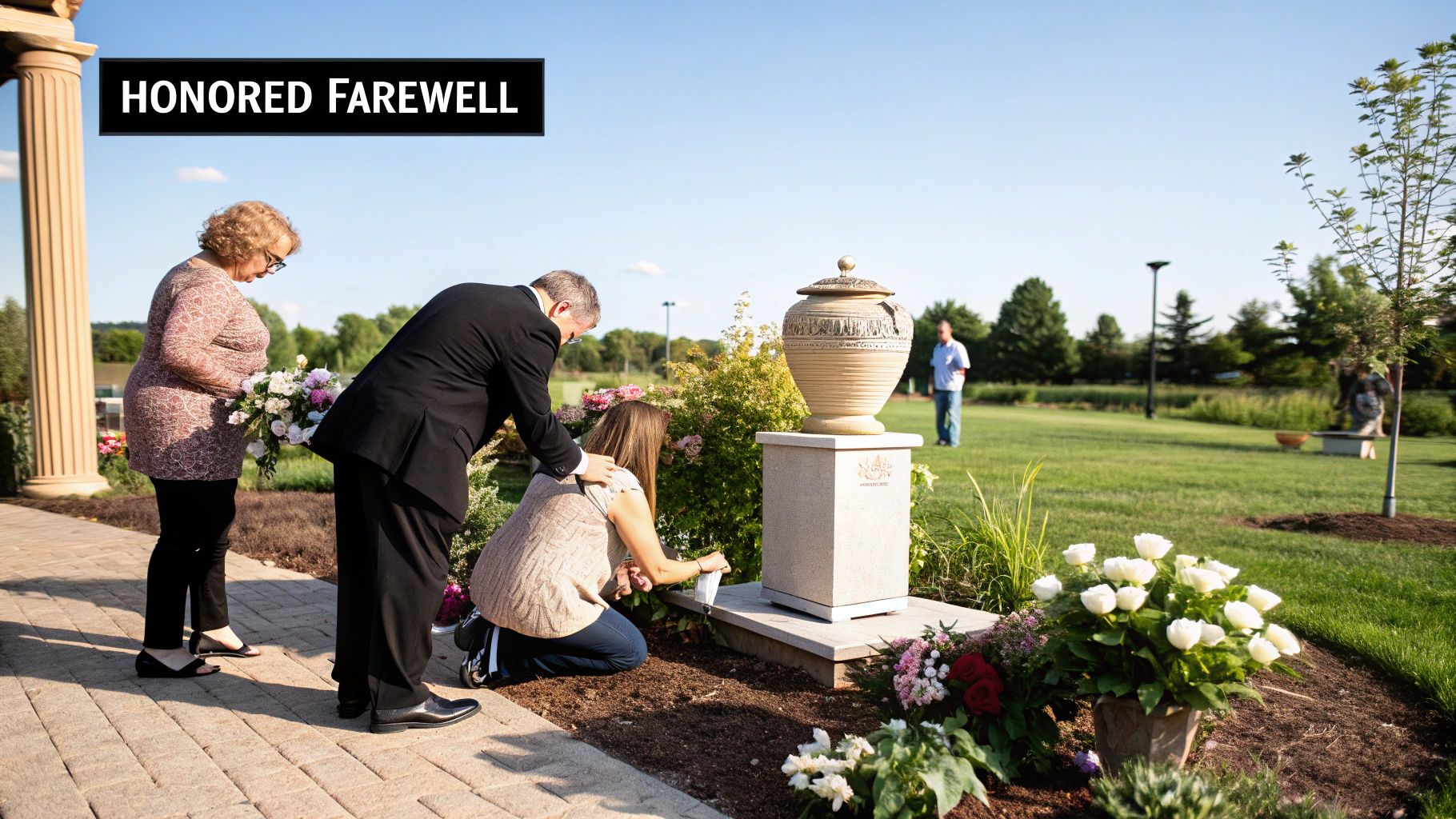When it's time to say a final goodbye, the choices we make are deeply personal. They're often the last opportunity to honor someone's life and values. For more and more people, that means choosing a farewell that reflects a profound respect for the natural world. This is where a biodegradable urn for ashes comes in.
These urns offer a gentle and sustainable way to return a loved one to the earth. Made from materials like recycled paper, sand, salt, or natural wood, they are designed to break down over time, ensuring the ashes become one with nature without leaving a trace. It’s a meaningful alternative to a traditional urn, transforming a final farewell into an act that nurtures the very earth we all come from.
Choosing a Gentle and Sustainable Farewell
Planning a memorial is a difficult, emotional journey. It's about finding comfort and creating a tribute that feels right. This guide is here to help you explore how a biodegradable urn can provide that comfort, creating a memorial that feels both respectful and life-affirming.
We'll look at what these urns are, the beautiful, natural materials they're made from, and how they allow for a truly dignified return to the elements.
Embracing an Eco-Conscious Memorial
The shift toward environmentally friendly memorials comes from a simple, powerful idea: that our final act can be one of giving back to the planet. Instead of a permanent, static marker, a biodegradable urn allows a final resting place to become part of a living, breathing ecosystem.
This choice offers a unique kind of peace and solace:
- A Return to Nature: It allows a loved one’s remains to rejoin the natural cycle of life, which can bring a profound sense of continuity and peace.
- A Living Legacy: Some urns are even designed to nourish a new tree, creating a living monument that will grow and flourish for generations. If this idea resonates with you, we have a detailed guide on how to plant a tree with ashes.
- Reduced Environmental Impact: By their very nature, these urns are crafted from sustainable materials that decompose without releasing toxins, helping to preserve the natural beauty of our landscapes.
Choosing a biodegradable urn transforms a final goodbye into a gesture of renewal. It’s a way to ensure a legacy is not just remembered but is also woven back into the fabric of the earth, supporting life long after a loved one has passed.
At Aerial Ash Scattering, we understand how important it is to make a thoughtful, informed decision during such a tender time. We’re here to walk with you through every step, helping you create a farewell that is respectful, gentle, and truly sustainable.
What Makes a Memorial Urn Biodegradable?

When we hear the word "biodegradable," it’s easy to think of something that just breaks down over time. But with a memorial urn, the idea is so much more meaningful. It’s not just about disappearing—it's about a quiet, deliberate return to the earth without leaving a harmful footprint.
The best way to think of a biodegradable urn for ashes is less like a permanent container and more like a seed pod. Its job is to protect what’s inside for a short time and then gently give way, letting its contents rejoin the natural cycle of life. That entire philosophy drives its design and construction.
These urns are made exclusively from organic, earth-friendly materials. This is a non-negotiable part of the design. It guarantees that when the urn is placed in soil or water, it becomes part of the environment, offering nutrients instead of pollutants.
The Science of a Natural Return
So, how does it actually work? The "magic" is all down to nature's own recycling crew: microorganisms. The bacteria and fungi that are naturally present in soil and water get to work, consuming the organic materials of the urn. They break it all down into the simplest building blocks of life—water, carbon dioxide, and organic matter.
This is a world away from how synthetic materials, like plastic, behave. Plastic can stick around for hundreds of years, slowly leaching chemicals into the ground. A genuinely biodegradable urn is engineered to do the complete opposite.
- For Land Burial: An urn made from something like pressed paper, cornstarch, or sustainably harvested wood will gradually soften once it's in the ground, thanks to the moisture and microbes in the soil. Over a few months or years, it simply becomes part of the earth it’s buried in.
- For Water Ceremonies: Urns intended for water are often made of materials like sand, salt, or gelatin. They're designed to dissolve relatively quickly, perhaps floating for a few moments before sinking and breaking apart to release the ashes. They do this without harming the aquatic ecosystem.
This move toward greener memorial options is really changing the industry. The numbers tell the story: the global market for degradable urns was valued at around USD 1.05 billion and is expected to climb to USD 1.78 billion by 2030. You can learn more about the research driving this trend toward green funerals to see just how significant this shift is.
More Than Just a Container
At the end of the day, what makes an urn biodegradable is its commitment to working in harmony with nature. Choosing one is a conscious decision to honor a life in a way that respects both their memory and the planet we all share.
A biodegradable urn isn’t just a vessel for holding ashes; it's a vehicle for transformation. It facilitates a final, graceful journey back to the elements, ensuring a legacy of life and renewal.
Understanding this is key to appreciating both the science and the sentiment behind this beautiful choice. It’s about making a final act as gentle and life-affirming as the person being remembered.
Exploring Natural Materials Used For Eco-Friendly Urns
The real beauty of a biodegradable urn for ashes comes from the simplicity and elegance of the materials themselves. Each one tells its own story, offering a unique way to honor a loved one's connection to the earth. These aren't just random materials; they're thoughtfully chosen for their ability to break down gracefully and become one with nature again.
From urns that dissolve peacefully in water to those that slowly merge with the soil, the variety available today allows for a final tribute that feels both personal and profound. Let's take a look at some of the most common and compelling choices.
Urns Designed for Water Ceremonies
When planning a memorial at sea, on a lake, or in a flowing river, you’ll want an urn specifically designed for a water ceremony. These urns are crafted to provide a serene and beautiful moment of farewell, often floating for a short time before making a gentle descent.
Two of the most popular choices are:
- Sand and Gelatin: These urns are created by compressing sand with a natural binding agent like gelatin. They hold their shape perfectly above water but begin to dissolve within hours of being placed in the water, allowing for a gentle release of the ashes.
- Himalayan Salt: Carved from solid blocks of ancient rock salt, these urns are truly one-of-a-kind. Each one has its own distinct colors and mineral patterns. Salt urns dissolve quite quickly, often within a few minutes, creating a poignant and immediate return to the elements.
The goal of these water-soluble urns is to ensure a seamless transition. They allow for a beautiful ceremony while being a respectful act that leaves no trace behind, which is crucial for protecting our fragile aquatic ecosystems.
Materials Ideal for Land Burial
When the final resting place is on land—perhaps in a green cemetery, a memorial forest, or a family garden—the materials are chosen for their ability to integrate with the soil. These urns are designed to decompose naturally when they come into contact with the earth and moisture.
This infographic gives a quick comparison of how long three common land burial materials take to decompose.

As you can see, the time it takes for an urn to fully break down can vary quite a bit depending on what it's made of. This gives families the flexibility to choose an option that feels right for their memorial wishes.
Comparing Common Biodegradable Urn Materials
To make the choice a bit clearer, here's a side-by-side look at some of the most common materials, where they work best, and what you can expect from them.
| Material Type | Best For | Decomposition Time (Approx.) | Key Feature |
|---|---|---|---|
| Recycled Paper/Cardboard | Green burial in a cemetery or private garden | 3-12 months | Lightweight, affordable, and made from recycled pulp. |
| Sustainably Sourced Wood | Land burial, offers a traditional aesthetic | 3-10+ years | Durable and classic, made from untreated pine or poplar. |
| Bamboo | Land burial | 1-5 years | Made from a highly renewable and sustainable resource. |
| Himalayan Salt | Water ceremonies (ocean, lake, deep river) | Under 4 hours | Dissolves quickly; each urn is unique in color. |
| Sand and Gelatin | Water ceremonies | Several hours to 3 days | Floats briefly before gently sinking and dissolving. |
Each material offers a slightly different experience and timeline, helping you find the perfect fit for the intended farewell.
Common Materials For Earth Burials
Let's dive a little deeper into the land-based options:
- Recycled Paper and Cardboard: Often molded into simple yet dignified shapes, these urns are made from pressed paper pulp. They are lightweight, generally more affordable, and will break down within a few months to a year, depending on the soil conditions.
- Bamboo: As one of the world's fastest-growing plants, bamboo is a fantastic sustainable resource. Urns made from bamboo are strong above ground but begin to decompose steadily once buried, making them a top eco-friendly choice.
- Sustainably Sourced Wood: For those who appreciate a more traditional feel, an urn made from untreated, sustainably harvested wood like pine is a wonderful option. While they take longer to decompose, they offer a timeless, classic look. If you're drawn to this style, you can learn more about the artistry behind handcrafted wooden urns and see if they're right for your needs.
Ultimately, each material provides a distinct way to reconnect with the earth, ensuring the final tribute is as personal as the life it honors. At Aerial Ash Scattering, we believe that understanding these options is the first step toward creating a truly fitting and meaningful memorial.
Finding the Perfect Urn for Land and Water Ceremonies

Once you've explored the beautiful, natural materials available, the next step is choosing a biodegradable urn for ashes that’s right for your specific ceremony. The most important factor guiding this decision is the final resting place. Is it a quiet spot in the woods, or out on the open water? Each environment calls for a different kind of urn, crafted to ensure a respectful and graceful return to the earth.
More and more families are choosing these kinds of green farewells, and the market reflects this growing desire for eco-conscious options. The global degradable urns market is actually projected to grow at a CAGR of 7.8% and is expected to nearly double in value by the early 2030s. This shift is really being driven by a deeper environmental awareness and supportive regulations. You can read the full research about the degradable urns market to see the data behind this trend.
Urns Crafted for the Earth
For a land-based ceremony, you want an urn that will truly become one with the soil. These vessels are specifically designed to break down naturally after being buried, slowly releasing their contents back to the earth.
You'll generally find two main styles for land ceremonies:
- Planting Urns: These are truly special. They’re designed to transform the ashes into a new source of life. Many use a clever dual-chamber system; the ashes go in the bottom compartment, and a seed or young sapling is planted above them in a nutrient-rich mixture. As the urn biodegrades, the tree’s roots can reach down to the ashes, drawing nourishment and creating a living memorial that will stand for years to come.
- Burial Urns: These are a bit simpler and are perfect for burial in a green cemetery or on private land. They are often made from materials like bamboo, cornstarch, or recycled paper that protect the ashes until interment. Once in the ground, they begin their slow, natural process of decomposition, allowing the ashes to gently merge with the soil.
Urns Designed for the Water
Water ceremonies call for an entirely different kind of urn. These are engineered for a serene and moving release, typically made from materials like Himalayan rock salt or sand that are designed to dissolve in water.
The experience is profoundly symbolic. A water-soluble urn will often float for a few cherished moments, giving you time for reflection and a final goodbye before it gracefully sinks and releases the ashes, leaving no trace behind.
This design ensures a beautiful farewell that also protects marine ecosystems. To help create these moments, services like Aerial Ash Scattering can help families find unique and meaningful locations for a water-based tribute. If you're interested in this path, you can explore the different kinds of vessels in our guide to water-soluble urns for ash scattering.
How to Choose the Right Biodegradable Urn
Selecting a biodegradable urn for ashes is a profoundly personal process. It's about more than just finding a container; it's about honoring a life in a way that feels true to them while also considering practicalities like the final resting place. With so many thoughtful options now available, it helps to have a clear path for making a choice you can feel at peace with.
This isn't a niche decision anymore. Cremation is becoming increasingly common, with rates in North America exceeding 60% and over 55% in Europe. As more families choose cremation, many are also looking for final arrangements that align with their environmental values. This has led to a growing interest in eco-friendly urns that are both sustainable and beautifully personal. You can discover more insights about the cremation urn market to see just how much preferences are shifting.
Key Questions to Guide Your Decision
Before diving into the options, it’s helpful to take a step back and ask a few guiding questions. Thinking through these points will bring clarity and make the selection process feel less overwhelming, ensuring the urn you choose is perfectly suited for your plans.
Here’s what to consider:
- Where is the final resting place? The location is everything. A water burial at sea requires a very different urn than one meant for a green cemetery or a quiet spot in your own garden.
- What was their connection to nature? Think about what they loved. Was it the forest? The ocean? Tending to their flower beds? Choosing an urn that reflects a cherished landscape adds a beautiful layer of meaning.
- What is your timeline? Are you planning a ceremony soon, or will the urn rest at home for some time? While durable indoors, these urns are ultimately designed to return to the earth.
- What are the local rules? Public lands, parks, and waterways often have specific regulations for scattering or burying ashes. It's always a good idea to check with local authorities or a service like Aerial Ash Scattering to make sure you're clear on any guidelines.
Ensuring Authenticity and Quality
Once you have a better idea of what you’re looking for, the next step is to make sure the urn you choose is genuinely eco-friendly. The term "green" can be used pretty loosely, so it pays to know what to look for.
A truly biodegradable urn is crafted from 100% natural, non-toxic materials. It's designed to break down completely, leaving no trace behind and becoming one with the environment.
A great way to verify this is to look for certifications from trusted organizations like the Green Burial Council. This certification acts as a guarantee that the product’s environmental claims have been independently verified. By choosing a certified urn, you can be confident you’re making a decision that truly respects both your loved one and the planet.
Planning a Meaningful Memorial Ceremony

A biodegradable urn for ashes isn't just a container; it's the centerpiece of a final, deeply personal farewell. Planning this moment gives you a chance to craft a tribute that truly reflects the person you’re honoring. This final act of saying goodbye can be an incredibly meaningful part of the grieving process.
Because these urns are designed to break down, they do need to be handled with care. It's important to transport them securely, keeping them dry and safe from any bumps or drops right up until the ceremony. This makes sure the urn stays intact for its final purpose, whether that's a burial, planting, or a ceremony on the water.
Creating a Personal Ceremony
One of the most wonderful things about a biodegradable urn is the freedom it gives you to design a unique memorial. The ceremony can be as simple or as involved as you like, held in a place that meant the world to your loved one.
Here are a few heartfelt ideas to consider:
- A Tree Planting Ritual: You can transform the ashes into a living memorial with a planting urn. Placing it in a family garden or a dedicated memorial forest creates a tribute that will grow and flourish for years to come.
- Interment at a Natural Burial Ground: A green cemetery offers a serene and formal setting for interment that respects eco-conscious values, allowing the urn and ashes to gently return to the earth.
- A Cherished Landscape Scattering: Releasing the ashes at a favorite scenic overlook, along a beloved hiking trail, or in a wide-open field can turn a special place into a permanent point of remembrance.
A memorial ceremony with a biodegradable urn is a final gift—a gesture of love that honors a life while nurturing the earth. It closes a chapter with an act of renewal and grace, creating a poignant and lasting memory for all who attend.
For ceremonies that are a bit more complex, perhaps in a remote location, getting professional help can make all the difference. The team at Aerial Ash Scattering, for instance, specializes in handling these logistics, ensuring every detail is managed with care and respect. We help families create seamless, compliant tributes that are a perfect fit for their loved one.
Even as the primary urn returns to nature, many families find comfort in keeping a small portion of the ashes close. You might want to look into keepsakes for cremation ashes to hold onto a lasting, tangible memento.
Common Questions About Biodegradable Urns
Choosing a biodegradable urn is a deeply personal decision, and it’s completely normal to have a few questions about the practical side of things. Let's walk through some of the most common concerns to help you feel completely at ease with your choice.
Durability and Travel Concerns
A big question we often hear is, "How long will a biodegradable urn last if I keep it at home?" You can rest assured they are surprisingly sturdy. As long as you store the urn indoors in a place that's dry and away from the elements, it will remain intact indefinitely.
These urns are designed to break down only when they come into contact with soil or water. This gives you all the time you need to plan a ceremony that feels right, without any rush.
When it comes to traveling, many biodegradable urns are designed with airport security in mind. Materials like recycled paper or cornstarch can typically pass through an x-ray scanner without issue, making them TSA-friendly. Still, it's always a good idea to double-check the latest guidelines with both your airline and the TSA before you fly.
Use in Scattering Ceremonies
Are these urns a good choice for scattering? Absolutely. In fact, many are made just for that purpose. You'll find everything from simple paper scattering tubes designed for a beautiful release on land to elegant water-soluble urns that float for a moment before gracefully descending into the sea.
For services like ours at Aerial Ash Scattering, we often transfer the ashes into a specialized dispersal device to ensure the ceremony is as seamless and beautiful as possible.
A biodegradable urn offers a dignified, versatile, and eco-conscious way to say a final farewell. Getting familiar with these details, along with the local rules for ash scattering, empowers you to create a tribute that is both beautiful and respectful. You can learn more by exploring our guide that answers the question, "is it legal to spread ashes?".
At Aerial Ash Scattering, we are here to help you craft a respectful and beautiful final tribute. Explore our services to find a meaningful farewell that honors your loved one's memory. https://ashdive.com


